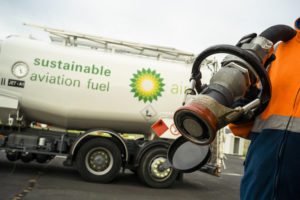Speaking at this year’s European Business Aviation Conference, chairman of the EBAA Juergen Wiese surmised the sector’s approach to sustainability: “You can have a vision but if you don’tact on it, then you stay a dreamer.”
Business Aviation’s Commitment on Climate Change goal is to reach net-zero carbon emissions by 2050.
However, there are much closer targets. The EU is aiming to cut emissions by 55% by 2030 compared to 1990 levels, while in the USA the target is achieve a 50% cut below 2005 levels by 2030. Aviation accounts for just 3.5% of greenhouse gas emissions currently, but it is one of the world’s fastest growing sources of emissions. The implication of the 2030 emissions reduction targets for aviation is clear – it’s time to stop dreaming and start acting.
The industry’s main approach to reducing emissions before electrification of aircraft becomes widespread is to use biofuels, known as Sustainable Aviation Fuel (SAF), as a drop-in fuel blended with Jet A. SAF is being used by business aviation operators today in a limited way, but there are challenges associated with its
wider adoption by the sector. Issues exist around awareness of SAF, its price and availability. The business aviation sector is leading the way in its adoption of SAF compared to commercial aviation. All of the sector’s major fuel producers and suppliers are offering or starting to offer SAF. They are also supporting its introduction, through both direct investment in the fuel’s production, distribution and industry education programs.
Most companies are also taking action on sustainability through reducing energy usage, the use of renewable energy sources and mechanisms such as mass balance and book and claim. But there is more to do to support the growth of SAF. Aviation is looking for governmental support.

At EBACE Weise was joined on stage by Ed Bolen, he president and CEO of the USA’s National Business
Aviation Association. He praised the “overwhelming focus on sustainability at EBACE” and pointed out that “in aviation a little incentive goes a long way”. In the USA, incentives for dropping in SAF to blends of
jet fuel include tax credits, supported by billions of dollars of investment, while the EU is adopting a mandated approach to the fuel’s introduction. This will start with an EU-wide mandate of 2% in 2025 growing to 5% by 2030. In the following pages, business aviation’s leading fuel
suppliers describe their approach to introducing SAF.
4AIR

Kennedy Ricci, president of sustainability program provider 4AIR, believes it is crucial for all of the stakeholders in business aviation – customers, FBOs, operators and manufacturers – to implement environmental programs.
“Aviation has no silver bullet solution to decarbonize so to drive meaningful progress we need to take a comprehensive approach to sustainability. This means employing a multi-faceted program that embraces each potential solution and its place in aviation’s sustainability journey. “Carbon offsets present a viable mechanism to counteract one’s emissions by financing the most cost-effective decarbonization opportunities across the globe. However, they are not a long term solution to reducing carbon emissions. “SAF will reach wider commercial availability and can unlock carbon neutral and even carbon negative fuels in the future. By looking at the lifecycle of the fuel and the source of the carbon, we can use feedstocks that recycle CO2 that was already in the biosphere. “Finally, new technology like electric and hydrogen aircraft will eventually find their place. We need to ensure we understand the impact of these technologies and implement them intelligently. “Meanwhile we need to look for improvements through advanced routing, operational efficiencies and better understanding of non CO2 effects. As you explore what sustainability means for you or your organization, consider a comprehensive program that builds a resilient and impactful strategy.
Air bp


Air bp has been involved with the development and testing of SAF since 2008 and to date has supplied the fuel to more than 20 airports around the world.
As a fuel company that is integrated across the supply chain and distribution network, Rieve believes that the company can offer customers the most value and carbon savings with SAF. “You need green hydrogen, access to renewable power, engineers who know how chemical conversions work and a distribution network. “As an integrated player, we are in a good place to take advantage as the market develops,” says Sven Rieve, sustainability advisor for bp. “By 2030 we would like to be supplying 20% of the world’s SAF.”
Rieve believes that liquid biofuels and efuels are the only solution for long haul flights, while electric aircraft will play a role in short haul. “SAF is the main way for aviation to decarbonize in the medium to long term,” he says. “But we need access to all the available feedstocks to meet decarbonization targets. There is not enough feedstock available to go with just one type.” Almost all SAF available today is HEFA (Hydroprocessed Esters and Fatty Acids), derived from vegetable oils, waste oils, or fats. In the future more sources will come online as production technology develops.
SAF will be produced from solid municipal waste, ethanol, agricultural waste. eSAF, synthetic fuel derived from renewable energy will also be part of the mix eventually. Air bp has projects in place to expand SAF production and has invested in a pilot program to produce SAF from municipal waste in the USA. Crucially Air bp wants to avoid using land that would normally be used for growing food crops for growing aviation biofuels. The introduction of standards will help to prevent this. Increasing uptake Rieve points out that increasing demand for SAF is fundamental to achieving future targets related to its use. He supports government intervention to kickstart the use of SAF in the form of mandates and incentives before it is more affordable.
“Policy needs to be made fast,” Rieve says. “Demand will drive supply expansion, investment in new plants and technology, increase competition and lower costs,” he says. “Aviation will be more costly to decarbonize than other sectors, so we need additional price support to make it happen as well as companies setting strong targets. It is an important way to scale up a nascent industry.” Meanwhile, a key challenge is aggregating demand. Moving SAF in small batches is impractical, especially compared to the supply chain for conventional jet fuel, which is highly optimized. Using the same supply chain or an additional supply chain SAF can create friction. “Larger deals will help to establish the supply chain, but business aviation has a very important role to play because the interest is very high,” Rieve says. Airports and FBOs are some of the key stakeholders for SAF’s roll out because unlike large commercial airports, FBOs do their own fueling. “They have more control and can really help drive demand and make solutions with SAF possible,” Rieve says. “They have more control over what fuel is used at their sites.”
A key moment will be when mandates are introduced. A compliance market has strict requirements to meet, while a voluntary market is not as structured. Combined with the shortage of supply of SAF, the market becomes a little bit more complex. “It is not a binary choice to have or not have SAF. There are discussions to have around feedstocks, overall greenhouse gas savings, whether you need to physically segregate it or if you use a mass balancing approach or book and claim,” says Rieve.
AEG Fuels

AEG Fuels provides fuel, trip support, ground handling and supply chain management on every continent to business aviation, airlines, governments and NGOs. The company offers a carbon offset program and book and claim alongside its SAF-offering. Stephen J Leonard is vice president of global supply at AEG Fuels, which supports industry efforts to develop a pathway to carbon neutrality and environmental integrity.
“Our role is to provide transparency, education and ease of access to SAF,” says Leonard. “We are committed to working with producers to develop offtake agreements and supporting footing the bill on introducing it to the industry.” Like most fuel suppliers AEG’s sales of SAF is restricted by the fuel’s availability. But Leonard believes that will start to change from this month thanks to the launch of the company’s SAF platform through its web portal.
AEG’s web portal offers a single place to get quotes for jet fuel from more than 3,000 airports, place orders, report on consumption, check invoices and purchase carbon offsets. From this month customers can also use the portal to see which AEG-partner airports in the world offer SAF, view prices and order it. “We want to make it as easy as possible for customers to procure SAF through their regular purchasing channels,” says Leonard. “Much of what currently exists in our industry today is focused on marketing SAF within each provider’s own FBO network or at a specific airport. Our view is that AEG should leverage our network of counterparties to create a turnkey global offering and increase visibility to SAF availability.
“Our platform allows for SAF to be quoted, ordered, and delivered around the world with the click of a button and provides clear information about the path it took to come to market.” SAF quotes via the AEG platform include information about who produced the SAF, the feedstock, the blend ratio and the expected carbon reduction. The platform also integrates with AEG’s book and claim system. Earlier this year AEG began partnering with Austrian energy company OMV to introduce SAF at Vienna Airport. “There is a direct pipeline from OMV’s SAF refinery to Vienna Airport,” says Leonard. “This creates a natural sink for a book and claim program, we expect less overall carbon emissions from our supply chain because there are no trucks or ocean-going vessels transporting the SAF over a large distance.”
AEG is still asked is if SAF can be used as a direct replacement fuel, if it is the same specification as Jet A1, or if its quality is assured. Understanding on these questions in the industry has improved. Another change is that the higher price of SAF no longer surprises the market. Leonard believes there is a segment of customer to whom cost isn’t as large a barrier as other considerations. Primarily these are business jet operators with C-suite mandates or ESG (environmental, social, and governance) programs. “They want to operate carbon neutral as soon as possible and our platform enables them to start doing that,” says Leonard. “AEG can bridge the gap between supply, demand, logistics, and price to support expediting the increased production of SAF.
We want to connect ready buyers with interested producers.” While SAF production and supply increases, a blended approach to carbon reduction is required, using offsetting in conjunction with SAF, believes Leonard: “Offsets are a very productive and useful method of reducing overall carbon emissions. All operators should be incorporating offsets into their fuel budgets to keep pace with CORSIA and other changes to the regulatory environment. “The next 10-20 years will about be creating standardization and audit trails for feedstock and carbon emission reduction claims across the entire supply chain,” says Leonard. “The industry has to decide together what is possible and what is sustainable.
Avfuel


Avfuel provides SAF through its partnership with Neste at nine FBO locations and is quickly adding more FBOs and airports to this list. The company also supplies SAF to corporate flight departments and OEMs. Since January 2021 it has supplied more than 1,150,000 gallons of blended Neste MY Sustainable Aviation Fuel. The intention is to grow this volume substantially in the coming years. “In line with IATA, by 2025 we expect 2% of total jet fuel usage to be SAF, which could be enough to make it cost competitive with petroleum-based jet fuel,” says C.R. Sincock, II, executive vice president of Avfuel. “But reaching business aviation’s net zero targets by 2050 will require a collective effort industrywide to provide and embrace sustainable fuels. Only together can we reach this new height.” Avfuel is taking a multi-pronged approach to integrate SAF into the fuel supply chain. The company recently invested in Alder Fuels via Avfuel Technology Initiatives Corporation (ATIC) to off take up to 1 billion gallons of Alder’s SAF over the next 20 years — the largest global business aviation SAF agreement to date. Initial supply from the deal is anticipated to come online in early 2024.
Avfuel also conducts educational sessions and engages in direct outreach to encourage the use of SAF. It supplies Neste MY SAF for special events at FBOs, airports and major OEM bases across North America, participates in industry conferences and is an active member of the business aviation environmental and sustainability coalition. In addition, Avfuel offers a package of sustainability solutions to the market. This includes a voluntary carbon offset program, a book and claim program for full-load SAF deliveries and an aim to bring unleaded avgas to market.
Sincock says, “We took a leadership role in SAF early on, recognizing it as a key component to business aviation fully realizing its sustainability commitments. “It will take some time for SAF to become a full replacement to petroleum-based jet fuel. But when that time does come, we’ll be ready for it.” Driving uptake During the current early adopter stage, environmental considerations and awareness are the main drivers of SAF purchasing. In the future, this is expected to shift toward legislative drivers. In the US, these could be either financial incentives at the state or federal level for using SAF, or adopting a blender’s tax credit. “Governmental policies and regulations will be incredibly important,” says Keith Sawyer, Avfuel’s manager of alternative fuels. “Financial incentives at the state or federal level will help make SAF a more desirable product in terms of price, spurring demand and, therefore, production.”
As well as the introduction of legislation, Sawyer believes there will be several other key milestones in the roll out of SAF, such as more supply entering the market, and SAF production becoming more robust and efficient thanks to new technologies. Sawyer is confident that SAF prices will come down as production increases. “We expect the price differential to narrow as SAF supply increases to meet demand over the next five years,” he says.
Airports and FBOs also play a crucial role in SAF adoption. They must be willing to receive, store and sell SAF, and be knowledgeable about the fuel. “Airport and FBO staff members are on the front line for questions from operators about SAF, so they have to able to convey accurate information to pilots and passengers,” says Sawyer. “We work directly with interested FBOs and airports on the logistics of receiving, storing, handling, marketing and selling SAF, and we work closely with Neste on the logistics and marketing side of the fuel whenever we set up a new program for full-load SAF deliveries and supply location.”
World Fuel

World Fuel Services (World Fuel) has supplied over 27 million gallons of Sustainable Aviation Fuel (SAF) since 2015 to the aviation market. The company has SAF contracts with airports around Europe, including Farnborough, UK, Le Bourget, Paris and Bremen, Germany.
As a wholesaler of fuel, World Fuel is encouraging discussions with its customers about SAF and sustainability. “Customers want SAF, and sustainability is a cornerstone of the company’s future strategy,” says Matt Whitton, senior director of supply Europe, World Fuel Services. World Kinect Energy Services (World Kinect), World Fuel’s sustainability division, works with customers to share knowledge and help companies with their sustainability journey.

Core to World Kinect is a four-step approach to sustainability which includes measuring and planning, reducing environmental impact, sourcing renewable fuels and carbon offsetting. “World Kinect offers customers a consultative effort and complements our other areas. We also provide HVO and hydrogen, renewable diesel and electricity,” says Whitton. “If you can’t use SAF, there are other ways you can become more sustainable,” says Pete Stevens, vice president of global marketing – aviation and marine, World Fuel Services. “You can offset carbon emissions and book and claim, or reduce energy use elsewhere in your operation. Everyone needs to look at the whole picture and start planning for sustainability.” Book and claim is a marketbased methodology allowing anyone, anywhere to claim the carbon reduction benefit of SAF.
Obtaining SAF is a more complex undertaking than getting conventional jet fuel. “You need to audit the supply chain and prove you are achieving an 80% reduction in greenhouse gases. But complexity is not a barrier to using SAF. Constrained supply is more of an issue right now,” says Whitton. “It is a similar situation to when biodiesel was first introduced. We learned a lot from that. The processes and structures will simplify at some point, but we are trying to keep it as simple as possible for the customer.”
Sustainability audits and certification can be obtained for SAF and mass balance transactions. Mass balance is where SAF is purchased and used at just one airport to meet the mandated requirements of a fleet using a number of different airports. Book and claim, when a company pays the price difference between a SAF transaction in a different part of the fuel network, is not easily auditable and certifiable. Whitton says it will be a key moment for SAF’s rollout when it is. “Other key milestones are when government mandates and incentives come in. For SAF to happen, it needs government support.”
Book and claim, increasing demand and government support will create the positive investment environment needed for refineries and infrastructure to be built by producers, notes Stevens. World Fuel is also working with producers on new technology and supporting the construction of refineries to support this end of the supply chain. “We have made investments in producers such as Fulcrum Bioenergy. World Fuel works across the whole supply chain and sees our role as bridging the gap between producers and customers,” says Stevens. “That means we are also working closely with airports and FBOs providing consultancy and support in the places that want to supply SAF already.”
“There are many stakeholders involved, and we all have a part to play in ensuring the SAF rollout happens, but first, the right legislation needs to be in place. At the same time, OEMs need to keep developing more efficient aircraft, and each individual needs to consider their travel patterns,” says Whitton.





